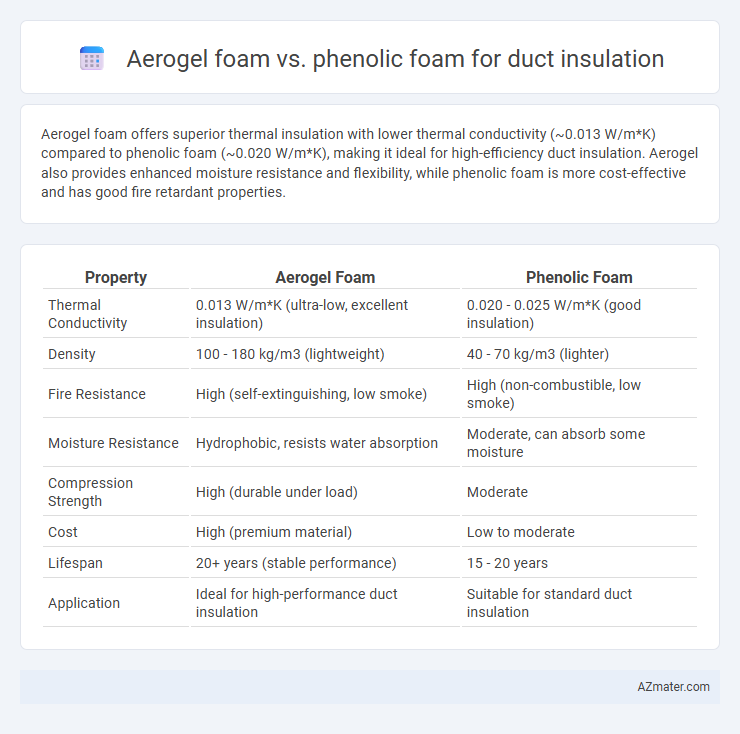Aerogel foam offers superior thermal insulation with lower thermal conductivity (~0.013 W/m*K) compared to phenolic foam (~0.020 W/m*K), making it ideal for high-efficiency duct insulation. Aerogel also provides enhanced moisture resistance and flexibility, while phenolic foam is more cost-effective and has good fire retardant properties.
Table of Comparison
| Property | Aerogel Foam | Phenolic Foam |
|---|---|---|
| Thermal Conductivity | 0.013 W/m*K (ultra-low, excellent insulation) | 0.020 - 0.025 W/m*K (good insulation) |
| Density | 100 - 180 kg/m3 (lightweight) | 40 - 70 kg/m3 (lighter) |
| Fire Resistance | High (self-extinguishing, low smoke) | High (non-combustible, low smoke) |
| Moisture Resistance | Hydrophobic, resists water absorption | Moderate, can absorb some moisture |
| Compression Strength | High (durable under load) | Moderate |
| Cost | High (premium material) | Low to moderate |
| Lifespan | 20+ years (stable performance) | 15 - 20 years |
| Application | Ideal for high-performance duct insulation | Suitable for standard duct insulation |
Introduction to Duct Insulation Materials
Duct insulation materials such as Aerogel foam and Phenolic foam play crucial roles in enhancing energy efficiency and thermal performance in HVAC systems. Aerogel foam is renowned for its extremely low thermal conductivity and superior insulating properties, making it ideal for minimizing heat loss or gain in ducts. Phenolic foam offers excellent fire resistance and moisture resistance, providing durable insulation that also meets stringent safety standards for duct applications.
What is Aerogel Foam?
Aerogel foam is an ultra-lightweight, highly porous material known for its exceptional thermal insulation properties, with thermal conductivity as low as 0.013 W/m*K, making it one of the most efficient insulators available for duct insulation. It consists of a silica-based structure with up to 99.8% air, providing superior fire resistance, hydrophobicity, and durability compared to traditional foams like phenolic foam, which typically exhibits higher thermal conductivity around 0.02 W/m*K. Aerogel foam's thin profile and flexibility allow for easier installation on complex duct geometries while maintaining high-performance insulation, contributing to enhanced energy efficiency in HVAC systems.
What is Phenolic Foam?
Phenolic foam is a rigid, closed-cell insulation material known for its excellent fire resistance, low smoke emission, and high thermal performance, making it suitable for duct insulation applications. It offers superior dimensional stability and moisture resistance compared to many other foam insulations, ensuring long-lasting efficiency in HVAC systems. Phenolic foam's unique chemical composition provides enhanced flame retardancy without the need for additional additives, distinguishing it from alternatives like aerogel foam.
Thermal Performance Comparison
Aerogel foam offers superior thermal insulation with a thermal conductivity as low as 0.013 W/m*K, significantly outperforming phenolic foam, which typically ranges from 0.020 to 0.025 W/m*K. This low thermal conductivity in aerogel foam reduces heat transfer more effectively, making it ideal for high-performance duct insulation applications where energy efficiency is critical. Phenolic foam, while cost-effective and fire-resistant, provides moderate thermal performance but cannot match the insulating efficiency and thin-profile benefits of aerogel foam.
Fire Resistance and Safety Ratings
Aerogel foam offers superior fire resistance for duct insulation with an impressive ASTM E84 Class A rating, significantly outperforming phenolic foam, which typically achieves a Class B or C rating. Aerogel's low thermal conductivity and non-combustible composition enhance safety by reducing flame spread and smoke generation during fire incidents. Phenolic foam, while cost-effective and providing moderate fire retardancy, emits more toxic fumes under high heat, making aerogel foam the preferred choice for stringent fire safety standards in HVAC systems.
Moisture Resistance and Durability
Aerogel foam offers superior moisture resistance due to its hydrophobic properties, preventing water absorption and maintaining thermal performance in duct insulation applications. Phenolic foam, while providing good fire resistance and thermal insulation, tends to absorb moisture over time, which can degrade its insulating efficiency and structural integrity. The durability of aerogel foam surpasses phenolic foam in damp or humid environments, making it a preferred choice for long-lasting, moisture-resistant duct insulation solutions.
Weight and Installation Considerations
Aerogel foam offers superior lightweight properties compared to phenolic foam, significantly reducing the overall load on ductwork and facilitating easier handling during installation. Phenolic foam, while denser and heavier, provides rigid structural support but may require additional labor and time due to its weight and brittleness. The choice between aerogel and phenolic foam directly impacts installation efficiency and long-term maintenance costs based on project weight constraints and ease of application.
Environmental Impact and Sustainability
Aerogel foam offers superior environmental benefits for duct insulation due to its exceptional thermal performance, which reduces energy consumption and lowers greenhouse gas emissions over its lifecycle. Phenolic foam, while effective as an insulator, involves formaldehyde in its production process, raising concerns about air quality and sustainability. The superior durability and recyclability of aerogel foam make it a more sustainable choice compared to phenolic foam, which often results in higher waste and limited end-of-life options.
Cost Analysis: Aerogel vs Phenolic Foam
Aerogel foam for duct insulation typically incurs higher initial costs due to its advanced nanoporous structure and superior thermal performance, which can reduce energy expenses over time. Phenolic foam offers a more cost-effective upfront solution with lower material and installation expenses but may require more frequent replacements or thicker layers to achieve similar insulation values. Evaluating the total cost of ownership involves balancing Aerogel's premium price against its longevity and energy savings compared to Phenolic foam's budget-friendly purchase price and moderate insulation efficiency.
Choosing the Right Foam for Duct Insulation
Aerogel foam offers superior thermal conductivity as low as 0.013 W/m*K, making it highly effective for minimizing heat loss in duct insulation compared to phenolic foam, which typically has thermal conductivity around 0.02 W/m*K. Phenolic foam excels with inherent fire resistance and low smoke emission, meeting strict fire safety standards essential for HVAC applications. Selecting the right foam involves balancing aerogel's outstanding insulation performance and thin profile with phenolic foam's cost-effectiveness and fire-retardant properties depending on project-specific thermal efficiency and safety requirements.

Infographic: Aerogel foam vs Phenolic foam for Duct insulation
 azmater.com
azmater.com